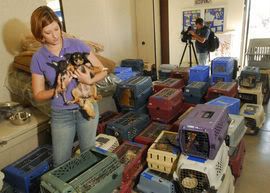 Animal care specialists with the Humane Society of Southern Arizona are accepting and cataloging approximately 752 small dogs and 36 exotic birds in what investigators believe is a case of animal hoarding.
Animal care specialists with the Humane Society of Southern Arizona are accepting and cataloging approximately 752 small dogs and 36 exotic birds in what investigators believe is a case of animal hoarding.On the morning of March 10th, officers with Pima County Sheriff’s Dept responded to the triple-wide mobile home and found hundreds of the dogs. Some are very ill and some have already passed away. To care for the surviving dogs, HSSA is assembling pens at its shelter to house the dogs as comfortably as possible while permanent homes are found.
Some neighbors figured Billy and Wanda Jones kept about 50 dogs; others thought about 150. No one in their wildest estimate guessed more than 700.
Do you suspect a neighbor might be hoarding animals?
RECOGNIZING ANIMAL HOARDING
• Area smells of ammonia
• Litter dumped in yard
• Hoarder seems isolated, has little contact with neighbors and family
• Resident tends to deny reality, insisting sick animals are healthy and that confined animals are comfortable
• Lots of animals in yard or in cages
• Stray animals gravitate toward specific house
• Animals have sores, overgrown toenails and hair loss around their noses, eyes, backs and hips
FAST FACTS
• Most hoarders are elderly females with a history of being a caregiver.
• Almost 75 percent of hoarders are single, divorced or widowed.
• In 69 percent of hoarding cases, animal feces and urine were found in indoor living areas, while more that 25 percent of the hoarders' beds were soiled with feces or urine.
• Cats are involved in 65 percent of hoarding cases.
• Hoarders not only "collect" animals, but other things, such as plants, newspapers and plastic bags.
• The Pima Animal Care Center has retrieved cats, dogs, pigeons, rabbits, pot-bellied pigs and marsupials from hoarders.
Sources: Pima Animal Care and Tufts University's Hoarding of Animals Research Consortium
Source: Tucson Citizen
